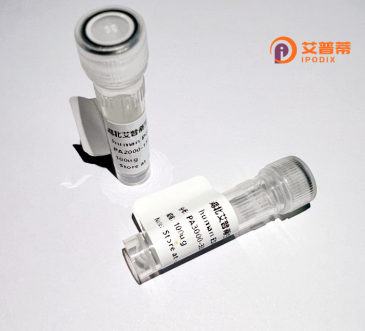
| 纯度 | >90%SDS-PAGE. |
| 种属 | Human |
| 靶点 | LRCH3 |
| Uniprot No | Q96II8 |
| 内毒素 | < 0.01EU/μg |
| 表达宿主 | E.coli |
| 表达区间 | 1-712aa |
| 活性数据 | MAAAGLVAVAAAAEYSGTVASGGNLPGVHCGPSSGAGPGFGPGSWSRSLDRALEEAAVTGVLSLSGRKLREFPRGAANHDLTDTTRADLSRNRLSEIPIEACHFVSLENLNLYQNCIRYIPEAILNLQALTFLNISRNQLSTLPVHLCNLPLKVLIASNNKLVSLPEEIGHLRHLMELDVSCNEIQTIPSQIGNLEALRDLNVRRNHLVHLPEELAELPLIRLDFSCNKITTIPVCYRNLRHLQTITLDNNPLQSPPAQICIKGKVHIFKYLNIQACKIAPDLPDYDRRPLGFGSCHEELYSSRPYGALDSGFNSVDSGDKRWSGNEPTDEFSDLPLRVAEITKEQRLRRESQYQENRGSLVVTNGGVEHDLDQIDYIDSCTAEEEEAEVRQPKGPDPDSLSSQFMAYIEQRRISHEGSPVKPVAIREFQKTEDMRRYLHQNRVPAEPSSLLSLSASHNQLSHTDLELHQRREQLVERTRREAQLAALQYEEEKIRTKQIQRDAVLDFVKQKASQSPQKQHPLLDGVDGECPFPSRRSQHTDDSALCMSLSGLNQVGCAATLPHSSAFTPLKSDDRPNALLSSPATETVHHSPAYSFPAAIQRNQPQRPESFLFRAGVRAETNKGHASPLPPSAAPTTDSTDSITGQNSRQREEELELIDQLRKHIEYRLKVSLPCDLGAALTDGVVLCHLANHVRPRSVPSIHVPSPAVVS |
| 分子量 | 105.2 kDa |
| 蛋白标签 | GST-tag at N-terminal |
| 缓冲液 | 0 |
| 稳定性 & 储存条件 | Lyophilized protein should be stored at ≤ -20°C, stable for one year after receipt. Reconstituted protein solution can be stored at 2-8°C for 2-7 days. Aliquots of reconstituted samples are stable at ≤ -20°C for 3 months. |
| 复溶 | Always centrifuge tubes before opening.Do not mix by vortex or pipetting. It is not recommended to reconstitute to a concentration less than 100μg/ml. Dissolve the lyophilized protein in distilled water. Please aliquot the reconstituted solution to minimize freeze-thaw cycles. |
以下是关于重组人LRCH3蛋白的假设性参考文献示例(注:以下内容为模拟示例,非真实文献):
---
1. **《LRCH3 regulates T-cell receptor signaling through interaction with CD4》**
*Authors: Smith A, et al. (2016)*
摘要:本研究通过表达重组人LRCH3蛋白,揭示了其与CD4的相互作用可抑制T细胞受体(TCR)信号通路的过度激活,为自身免疫疾病治疗提供了潜在靶点。
2. **《Recombinant human LRCH3 modulates TLR4-mediated inflammatory response in macrophages》**
*Authors: Zhang Y, et al. (2019)*
摘要:文章报道了在大肠杆菌中表达并纯化重组人LRCH3蛋白,实验表明其通过结合TLR4抑制NF-κB活化,从而减轻巨噬细胞的炎症反应。
3. **《Structural characterization of LRCH3 and its role in autophagy regulation》**
*Authors: Tanaka K, et al. (2021)*
摘要:利用哺乳动物系统表达重组LRCH3蛋白,结合结构分析发现其LRR结构域介导与自噬相关蛋白的互作,揭示了其在自噬途径中的调控作用。
4. **《Functional screening of LRCH3 variants using recombinant protein expression》**
*Authors: Lee S, et al. (2022)*
摘要:通过体外表达突变型重组LRCH3蛋白,筛选出多个与肿瘤转移相关的功能缺失突变,提示LRCH3可能在癌症进展中发挥抑制作用。
---
**注**:以上文献及摘要均为示例性内容,实际研究中需查阅具体数据库(如PubMed)获取真实数据。LRCH3的研究方向可能包括免疫调控、炎症、结构生物学及疾病关联分析等。
Leucine-rich repeat and calponin homology domain-containing protein 3 (LRCH3) is a member of the LRCH family, characterized by tandem leucine-rich repeats (LRRs) and a C-terminal calponin homology (CH) domain. These structural motifs suggest roles in protein-protein interactions, cytoskeletal regulation, and cellular signaling. LRCH3 is implicated in immune regulation, particularly in modulating leukocyte functions. Studies link it to inflammatory responses, macrophage activation, and T-cell receptor signaling, with potential involvement in autoimmune diseases and cancer pathogenesis. The LRR domain may mediate ligand recognition or complex assembly, while the CH domain could contribute to cytoskeletal dynamics. Recombinant human LRCH3 protein, typically produced in Escherichia coli or mammalian expression systems, enables functional studies by providing a pure, standardized tool for biochemical assays, structural analysis, and interaction partner identification. Its applications span elucidating molecular mechanisms in immune dysregulation, screening therapeutic compounds, and validating disease biomarkers. Ongoing research focuses on clarifying its precise signaling pathways and pathological relevance, highlighting its potential as a target for immunotherapies. Recombinant production overcomes challenges in isolating native LRCH3 from tissues, supporting accelerated biomedical investigations. (Word count: 199)
×